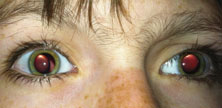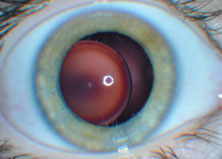ECPs can play vital role in diagnosis of Marfan syndrome
In a recent survey by the National Marfan Foundation, one-third of patients with Marfan syndrome reported that a dislocated lens was the first sign that they had the disorder, and one in five indicated that an eye care practitioner had been the first to suspect the diagnosis.
“Marfan syndrome is a genetic disorder affecting roughly one in 4,000 individuals,” Andrew W. Nahas, OD, said in an interview with Primary Care Optometry News. “There is a wide range of variability in its manifestations, from ocular findings to cardiovascular and musculoskeletal problems.”
Typical ocular manifestations of Marfan syndrome include significant refractive error, dislocation of the natural lens and an increased risk for retinal detachment, Nahas said.
Glaucoma can also result from pupillary block caused by an ectopic lens with spherophakia, but also from the developmental anomaly of the anterior chamber angle, he said. In addition, the underlying connective tissue defect may affect the lamina cribrosa.
In a press release distributed by the National Marfan Foundation (NMF), the foundation encouraged eye care practitioners to not only be aware of the ocular signs of Marfan syndrome, but also learn the other outward physical signs, so they may be more confident in referring a patient for further evaluation.


This 11-year-old boy was diagnosed with Marfan syndrome. The patient’s manifest refraction in the right eye was –10.50 D –0.25 D x 180, with a visual acuity of 20/40-2 and in the left eye was –8.50 D –2.00 D x 170, with a visual acuity of 20/25+1.
Images: Nahas AW
Marfan syndrome is often characterized by tall stature and disproportionately long legs and arms. Other skeletal manifestations are curvature of the spine, a protruding or indented chest and loose joints. The most serious problem associated with Marfan syndrome is its effect on the aorta, which is prone to progressive enlargement and can lead to tears in the aortic wall that require surgery. If aortic enlargement and tears are left undetected, the aorta may rupture, leading to sudden death, the release said.
The OD’s role

Andrew W. Nahas
An optometrist’s role in managing Marfan syndrome would be to provide periodic eye exams monitoring the retina for any potential holes, tears or detachments as well as correcting the refractive error (myopia) for optimal vision while preventing amblyopia, Nahas said.
Early diagnosis is crucial, as it allows patients – before serious, life-threatening aspects of the syndrome present – to take medications to lower their heart rate and blood pressure; make lifestyle adaptations, such as eliminating competitive or contact sports; and have their aorta monitored more closely so that preemptive surgery may prevent a potentially fatal tear or rupture. The ocular issues, which include myopia, amblyopia, strabismus, glaucoma and retinal detachments, are often early signs of the condition and can certainly impact quality of life, the release said.
Making the diagnosis
“A 7-year-old girl was brought to me for an eye exam because a recent school screening indicated a vision measurement of about 20/100 in each eye,” Nahas said. “Her mother also noticed a ‘shimmering of the colored part’ of the left eye. She hadn’t yet developed the more pronounced musculoskeletal problems at that time, but I was the first to diagnose it. The shimmering was actually the loose lens shaking as light hit it in a certain way.”
The diagnostic process for Marfan syndrome derives a systemic score for the patient, with the various features of the syndrome embodying a numeric value, the NMF press release said.
The score system reflects three significant changes in the way Marfan syndrome is diagnosed. First, the two cardinal features of Marfan syndrome – aortic root dilation/dissection and dislocated lens – are weighted more heavily than other characteristics. Second, there is a more precise role for molecular testing. Third, less specific manifestations of Marfan syndrome are either removed or given much less weight in the evaluation process, the release said.
Also, the NMF has developed a mobile website (www.marfandx.org), which features a summary of the new diagnostic criteria, including seven simple formulae for diagnosing Marfan syndrome.
The site features an interactive systemic core calculator for considering the lesser characteristics of Marfan syndrome throughout the body that can be important in making a diagnosis. In addition, there is an interactive Z-score calculator to determine the size of the aorta in relation to body surface area, key points about the role of genetic testing and family history, important information on differential diagnosis and related disorders, and other helpful links and resources, according to the release.
The survey of 1,369 Marfan syndrome patients was conducted online through the NMF’s proprietary email network, the NMF Facebook page, NMFconnect (the NMF’s social networking platform) and Marfan List (an online discussion group). – by Daniel R. Morgan
